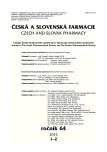Computational approach to search for novel antituberculostics
Authors:
O. Holas 1; F. Slovák 1; M. Doležal 1
Authors place of work:
Department of Pharmaceutical Chemistry and Drug Control, Faculty of Pharmacy in Hradec Králové, Charles University in Prague, Czech Republic
1
Published in the journal:
Čes. slov. Farm., 2015; 64, 39-40
Category:
Rozšířená abstrakta z konference
Introduction
Tuberculosis remains one of the world’s leading infectious diseases not only in developing countries. According to WHO there will be about 1 billion more people newly infected with tuberculosis and approximately 36 million deaths in 2020, if the worldwide ravage of tuberculosis is left unchecked. Mycobacterium tuberculosis multidrug resistant strains, HIV co‑infection and the prospect of nosocomial transition are currently highly problematic issues1). The current front line chemotherapeutics consist of isoniazid, pyrazinamide and rifampicin. Isoniazid’s discovery was a milestone of modern antitubercular treatment. It was first antitubercular compound confirmed as enoyl-ACP-reductase (InhA; EC 1.3.1.9) inhibitor. It disrupts the integrity of bacterial cell wall via inhibition of mycolic acids biosynthesis. Isoniazid is in fact a prodrug effective after its bioactivation by catalase/peroxidase enzyme complex. The mutation of catalase peroxidase/complex coding genes are often found at multidrug resistant strains. Mycobacterial InhA is an important enzyme catalyzing the final step of mycolic acids biosynthesis. It has been established within fatty acid synthase (FAS) II system as a promising target for the novel inhibitors. The development InhA of inhibitors effective without previous activation by catalase/peroxidase system, seems to be a rational approach2, 3).
Experimental method
We hereby present the virtual screening study. Molecular Operating Environment (MOE) software package, designed for drug design and discovery, was used throughout the experiments4). Three different InhA crystal structures were employed as target receptors. These receptors were chosen with respect to differently ordered substrate binding loop. There are generally three different substrate binding loop orientations: closed (ordered), semiopened and opened (pdb no: 2X23, 4TZK and 1P44 respectively). The small molecule dataset chosen for this study ZINC Natural Derivatives – chemically modified natural products database5) (almost 38 000 entries) was selected to be screened for substances with potential affinity towards the mycobacterial enoyl-ACP-reductase. Structures of the confirmed inhibitors used as standards in this study are displayed at Figure 1. Ligand originated from 2X23 crystal structure a diphenylether derivative PT70 had an affinity –9.9 kcal/mol. Pyrrolidine carboxamide inhibitor crystalized as ligand of 4TZK crystal structure was reducked with the affinity of –8.2 kcal/mol. 1P44 ligand was redocked with the affinity of –8.1 kcal/mol. The placement method used throughout the virtual screening was Alpha Triangle. The scoring function of choice was Affinity dG. Successful compounds were subsequently subjected to the molecular docking for further selection. Suitable candidates will be docked using the induced fit protocol in order to propose the binding mechanism of the most successful potential inhibitors.

Results
Only 4 compounds surpassed the affinity of –9.9 kcal/mol achieved by original ligand (1). Almost 100 compounds achieved the affinity towards 4TZK InhA higher than original ligand 2 (–8.2 kcal/mol) after its redocking. Over 500 hundred structurally different compounds surpassed original ligand 2 affinity towards 1P44 InhA. For the further docking were selected entries with affinity lower than –9.0 kcal/mol. More precise rigid receptor docking showed that approximately 20% of results were falsely positive and were excluded from further modeling. On the other hand several compounds show significantly higher affinity compared to preliminary virtual screening results. Figure 2 shows the pose of the currently best scored compound in the active site of 2X23 InhA. The affinity of this pose was –14.1 kcal/mol. The pose shows overlay with the dipenylether inhibitor 2. However the crucial hydrogen bond network with the Tyr158 is not present among this inhibitors interaction.

Conclusion
The affinity values suggest that ZINC-znd database supposedly contain compounds with the sufficient affinity towards mycobacterial InhA. Further experiments are needed to confirm this presumption. However we must register a binding pattern different from most of the established inhibitors. On the other it was proven that Tyr158 and NADH ribose hydrogen bond network is not the only possible effective binding mechanism among the InhA inhibitors.
The study was supported by project no. CZ.1.07/2.3.00/20.0235
Conflicts of interest: none
HOLAS O.1, SLOVÁK F.1, DOLEŽAL M.1
1Department of Pharmaceutical Chemistry and Drug Control, Faculty of Pharmacy in Hradec Králové, Charles University in Prague, Czech Republic
e-mail: ondrej.holas@faf.cuni.cz
Zdroje
1. Zingol M., Hosseini M. S., Wright A., Lamberts-van Weezenbeek C., Nunn P., Watt C, J. Williams B.G., Dye C. Global incidence of multidrug-resistant tuberculosis. J. Infect. Dis. 2006; 194; 479–485.
2. Loots D. T. An altered Mycobacterium tuberculosis metabolome induced by katG mutations resulting in isoniazid resistance. Antimicrob. Agents. Chemother. 2014; 58; 2144–2149.
3. Holas O., Ondrejček P., Doležal M. Mycobacterium tuberculosis enoyl-acyl carrier protein reductase inhibitors as potential antituberculotics: development in the past decade. J. Enz. Inhib. Med. Chem. 2014; Epub ahead of print; doi:10.3109/ 14756366.2014.959512
4. Molecular Operating Environment (MOE), 2013.08; Chemical Computing Group Inc., 1010 Sherbooke St. West, Suite #910, Montreal, QC, Canada, H3A 2R7, 2015.
5. Irwin J. J., Sterling T., Mysinger M. M., Bolstad E. S., Coleman R. G. ZINC: A Free Tool to Discover Chemistry for Biology. J. Chem. Inform. Model. 2012; 52; 1757–1768.
Štítky
Farmacie FarmakologieČlánek vyšel v časopise
Česká a slovenská farmacie

2015 Číslo 1-2
- Mikroplasty a jejich riziko pro zdraví: Co všechno víme?
- Ukažte mi, jak kašlete, a já vám řeknu, co vám je
- Top zaměstnavatelé ve zdravotnictví si hýčkají už studenty
Nejčtenější v tomto čísle
- Biologická dostupnost léčiva a možnosti jejího ovlivňování
- Účinnost fytoterapie v podpůrné léčbě diabetes mellitus typu 2 Borůvka černá (Vaccinium myrtillus)
- Užívání vybraných OTC přípravků: srovnání Řecko a Česká republika
- Vliv velikosti otvoru kónické testovací násypky na parametry rovnice sypání sorbitolu a jeho velikostních frakcí
